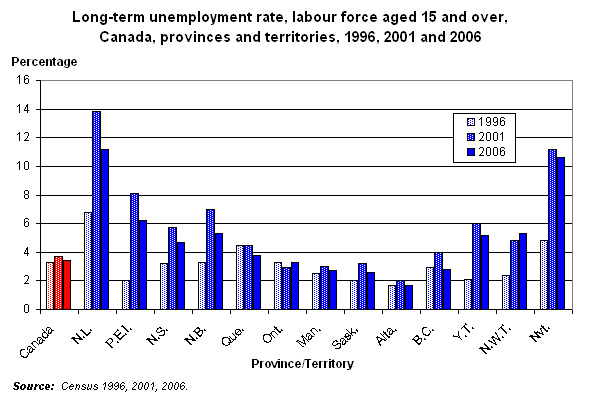Long–term unemployment
Archived Content
Information identified as archived is provided for reference, research or recordkeeping purposes. It is not subject to the Government of Canada Web Standards and has not been altered or updated since it was archived. Please "contact us" to request a format other than those available.
Long-term unemployment is defined as the proportion of the labour force aged 15 or older who did not have a job any time during the current or previous year (for example, the years 2005 and 2006 for the 2006 Census). The labour force consists of people who are currently employed and those who are unemployed but were available to work in the reference period and had looked for work in the past four weeks.
Importance of indicator
Unemployment is a risk factor for physical and mental illness and mortality. Mechanisms linking unemployment to ill health include financial stress; loss of self–esteem, social status and interpersonal contact; and increases in health risk behaviours1,2.
Background
Men were more likely than women to experience long–term unemployment3.
Other groups likely to experience long–term unemployment were older workers and those with fewer years of education3. Prolonged unemployment among older workers has been attributed to age discrimination as well as a preference for training younger workers in anticipation of a longer return on that investment4.
The prevalence of long–term unemployment was relatively high among recent immigrants; possible reasons include lack of recognition for foreign qualifications, inexperience in the Canadian job market, and lack of knowledge of English and/or French4.
As the duration of unemployment increased, prospective workers were less likely to contact employers directly and more likely to seek work by looking at job advertisements5.
Highlights and graph
Time trend

- Between 1996 and 2006, long-term unemployment hovered between 3% and 4%.
- Long-term unemployment was generally higher in the Atlantic Provinces and the territories: in 2001, the rate was 14% in Newfoundland and Labrador, followed by Nunavut at 11%.
- From 2001 to 2006, long term unemployment either stabilized or dropped in most provinces and territories.
- In Quebec, Ontario, the Prairie Provinces and British Columbia, the long–term unemployment rate remained relatively low at around 4% or less throughout the period.
References
1. Bartley M, Ferrie J, Montgomery SM. Living in a high-unemployment economy: understanding the health consequences. In: Marmot M, Wilkinson RG, eds. Social Determinants of Health. New York: Oxford University Press, 2000.
2. Harvey Brenner M. Political economy and health. In: Amick III BC, Levine S, Tarlov AR, Chapman Walsh D, eds. Society and Health. New York: Oxford University Press, 1995.
3. Dubé V. Sidelined in the labour market. Perspectives on Labour and Income (Statistics Canada, Catalogue 75-001) April 2004;5(4):5-11.
4. Dubé V, Dionne C. Looking, and looking, for work. Perspectives on Labour and Income (Statistics Canada, Catalogue 75-001) May 2005;6(5):10-14.
5. Grenon L. Looking for work. Perspectives on Labour and Income (Statistics Canada, Catalogue 75-001) Autumn 1998;10(3):22-26.
- Date modified:
